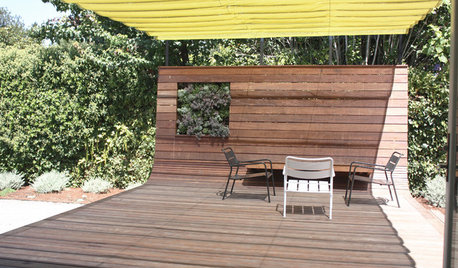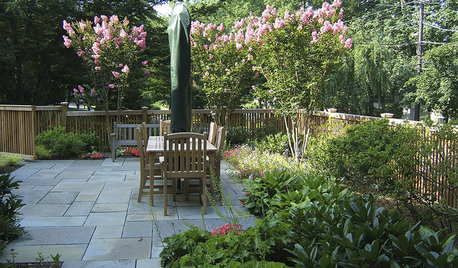Gritty Mix question about bark
jersey21
8 years ago
Featured Answer
Sort by:Oldest
Comments (13)
Related Discussions
gritty mix bark size question (w/picture)
Comments (7)If you want to use it, I would use a wick to help drain any excess water. The whole purpose of the gritty mix is to build a soil that holds it's water INSIDE of particles instead of between them. Reducing particle size creates a perched water table, so you almost might as well use the 5:1:1 mix. I'm offering that observation purely from a practical perspective. If you do use a wick to help get the benefits from a fully drained soil, you can just remove the wick once the planting has matured & roots have colonized the soil mass. At that point, air will return to the whole soil mass quickly enough that the short duration of soggy soil won't likely have a significant effect. Al...See MoreHow about leaving the bark out of the gritty mix?
Comments (9)"that held about the same volume of water as the average between the Turface >and granite", "Each of the ingredients in the gritty mix is actually carefully chosen. Particle size, the ability to hold/not hold water" "I've been using the gritty mix for about 15 years, and haven't found a way to improve it yet" From what I take from this, I would say the bark serves a very useful purpose and is indeed needed, just my thought. I suppose you can grow in anything you want the way you want in anything.. I have grown plants in just pebbles, peat alone, bark alone, sand alone and so on. They only did well for so long though.. I am currently growing a jade in just "turface" and a christmass cactus in just turface and granite because I ran out of the bark fines at one time, and needed to plant quick and for now they seem to be doing well... For some reason though, the christmass cactus and jades in the gritty mix seems to be doing a heck of alot better than the ones in just turface and granite...:-)...See MoreGritty Mix questions about turface, watering, and bark
Comments (5)Drew is full of it and aparently never reads any studies that get posted showing that Turface increases the available water in various container media. Turface DOES NOT hold onto water so tightly that the plants can't utilize stored water. There is a point as the mix dries where water that is held in the turface becomes unavailable, but that can be said of plain old garden soil too. Much of the water held in turface is available. That said, the moisture retention curve for axis (DE) is better at holding water that is available to plants than turface (calcined clay) You can use the sifted turface in your garden. Studies have shown it toimprove both sandy and clay soils....See MoreQuestion about transfering plants to gritty mix?
Comments (4)"Worry about all the excess dirt." Get as much off as you can. There are many experts here. They know TONS more than I do. If you do a couple of searches up in the search box, you will find YEARS of threads on gritty mix and its variations, often with 30 comments per thread -- and HOW to pot. Josh and others have described at length how to bareroot a plant in warm water by dipping and even hosing, how to solidify it in the pot with gritty mix, how to poke out the air pockets as the mix settles, how to isolate it for a few days etc. It is worth doing the research....See Morejersey21
8 years agojodik_gw
8 years agojersey21
8 years agojersey21
8 years agojersey21
8 years ago
Related Stories

GARDENING GUIDESNew Ways to Think About All That Mulch in the Garden
Before you go making a mountain out of a mulch hill, learn the facts about what your plants and soil really want
Full Story
PAINTINGWhat to Know About Milk Paint and Chalk Paint — and How to Use Them
Learn the pros, cons, cost and more for these two easy-to-use paints that are great for giving furniture a vintage look
Full Story
PETSSo You're Thinking About Getting a Dog
Prepare yourself for the realities of training, cost and the impact that lovable pooch might have on your house
Full Story
WORKING WITH PROSWhat Do Landscape Architects Do?
There are many misconceptions about what landscape architects do. Learn what they bring to a project
Full Story
LIGHTINGWhat to Know About Switching to LED Lightbulbs
If you’ve been thinking about changing over to LEDs but aren't sure how to do it and which to buy, this story is for you
Full Story
DECKSA Family-Friendly California Yard Wises Up About Water
Pavers and unthirsty plants replace Kentucky bluegrass in a Menlo Park landscape for a family of 4
Full Story
KITCHEN DESIGNNew This Week: 2 Kitchens That Show How to Mix Materials
See how these kitchens combine textures, colors and materials into a harmonious whole
Full Story
LAUNDRY ROOMSSoak Up Ideas From 3 Smart Laundry Rooms
We look at the designers’ secrets, ‘uh-oh’ moments and nitty-gritty details of 3 great laundry rooms uploaded to Houzz this week
Full Story
GARDENING GUIDESGreat Design Plant: Crape Myrtle
With long-lasting blooms and gorgeous exfoliating bark, this ornamental tree brings bright color and a unique form to the landscape
Full Story
MOST POPULARHow High Should You Mount Your TV?
Today we look at an important question to consider when locating your television: How high should you set it?
Full StorySponsored
Zanesville's Most Skilled & Knowledgeable Home Improvement Specialists




rooftopbklyn (zone 7a)